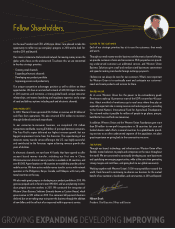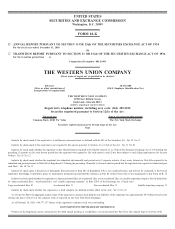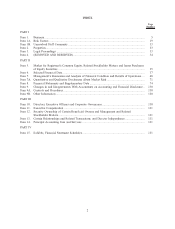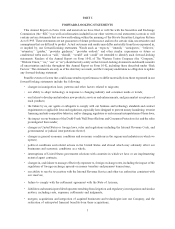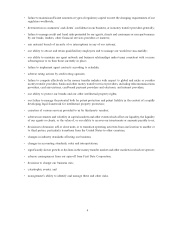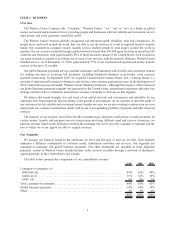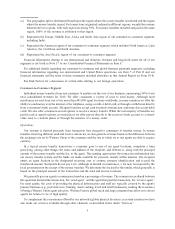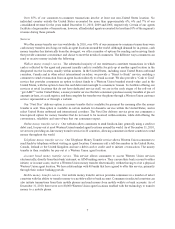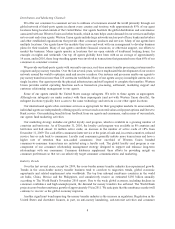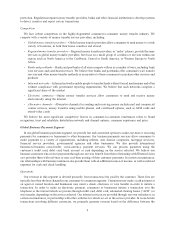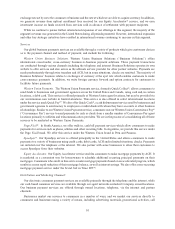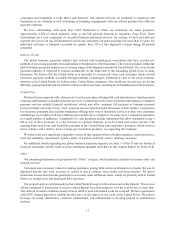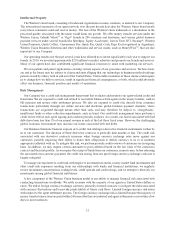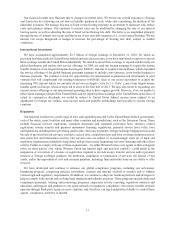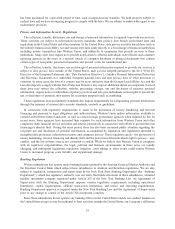Western Union 2010 Annual Report Download - page 10
Download and view the complete annual report
Please find page 10 of the 2010 Western Union annual report below. You can navigate through the pages in the report by either clicking on the pages listed below, or by using the keyword search tool below to find specific information within the annual report.Distribution and Marketing Channels
We offer our consumer-to-consumer service to millions of consumers around the world primarily through our
global network of third-party agents in almost every country and territory, with approximately 85% of our agent
locations being located outside of the United States. Our agents facilitate the global distribution and convenience
associated with our Western Union and other brands, which in-turn helps create demand for our services and helps
us to recruit and retain agents. Western Union agents include large networks such as post offices, banks and retailers
and other established organizations that provide other consumer products and services. Many of our agents have
multiple locations. Our agents know the markets they serve and work with our management to develop business
plans for their markets. Many of our agents contribute financial resources, or otherwise support, our efforts to
market the business. Many agents operate in locations that are open outside of traditional banking hours, for
example on nights and weekends. Our top 40 agents globally have been with us an average of approximately
14 years, and in 2010, these long-standing agents were involved in transactions that generated more than 60% of our
consumer-to-consumer revenue.
We provide our third-party agents with our multi-currency, real-time money transfer processing systems used to
originate and pay money transfers. Over the last several years, we have emphasized the development of our receive
network around the world to optimize send and receive corridors. Our systems and processes enable our agents to
pay money transfers in more than 120 currencies worldwide. Many of our agents can pay in multiple currencies at a
single location. Our agents provide the physical infrastructure and staff required to complete the transfers. Western
Union provides central operating functions such as transaction processing, settlement, marketing support and
customer relationship management to our agents.
Some of our agents outside the United States manage subagents. We refer to these agents as superagents.
Although our subagents are under contract with these superagents (and not with Western Union directly), the
subagent locations typically have access to the same technology and services as our other agent locations.
Our international agents often customize services as appropriate for their geographic markets. In some markets,
individual agents are independently offering specific services such as stored-value card payout options and Direct to
Bank service. Our marketing benefits from feedback from our agents and consumers, and in many of our markets,
our agents fund marketing activities.
Our marketing strategy includes our global loyalty card program, which is available in a growing number of
countries and territories. As of December 31, 2010, the loyalty card program was available in 80 countries and
territories and had almost 16 million active cards, an increase in the number of active cards of 18% from
December 31, 2009. The card offers consumers faster service at the point-of-sale and, in certain countries, reduced
service fees or cash back to consumers. Loyalty card consumers generally initiate more transactions and have a
higher rate of retention than non-carded consumers. Over one-third of Western Union branded
consumer-to-consumer transactions are initiated using a loyalty card. The global loyalty card program is one
component of our consumer relationship management strategy designed to support and enhance long-term
relationships with our consumers. Consumer databases supplement these efforts by providing insight on
consumer preferences so that we can selectively target consumer communications and marketing.
Industry Trends
Over the last several years, except for 2009, the cross-border money transfer industry has experienced growth.
Trends in the cross-border money transfer business tend to correlate to migration trends, global economic
opportunity and related employment rates worldwide. The top four inbound remittance countries in the world
are India, China, Mexico and the Philippines, and cumulatively receive an estimated $150 billion annually
according to The World Bank’s November 2010 report. Due to the weak global economy, including declines in
consumer confidence and high unemployment, the demand for money transfers has softened. The World Bank
projects cross-border remittance growth of approximately 5% in 2011. We anticipate that the remittance market will
continue to recover as the global economy improves.
Another significant trend impacting the money transfer industry is the increase in regulation. Regulation in the
United States and elsewhere focuses, in part, on anti-money laundering, anti-terrorist activities and consumer
8


